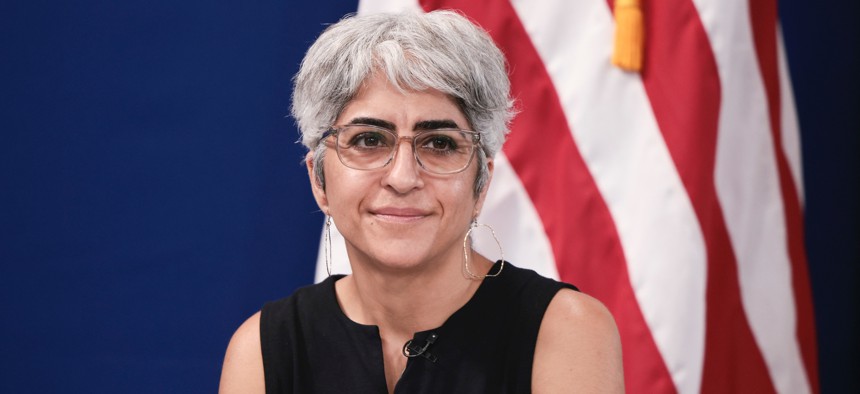
OPM director Kiran Ahuja has deployed tiger teams and other resources to help agencies ramp their hiring to meet the capacity needed for infrastructure projects. Anna Moneymaker / Getty Images
Agencies have hired nearly 5,500 feds to implement Biden's bipartisan infrastructure law
The Biden administration has surpassed its infrastructure law hiring goals, and plan to bring on another 1,000 personnel next year.
The Biden administration has filled 90% of the more than 6,000 jobs federal agencies have identified to implement the president’s signature infrastructure law, putting it ahead of its expected pace for the engineering, construction and other positions.
Agencies are planning to continue hiring to carry out the 2021 Infrastructure Investment and Jobs Act, with another 1,000 employees expected to come on board next year. The Office of Personnel Management had set the goal of filling 75% of the positions—and identifying 5,800 jobs—agencies will need to carry out the law by the end of fiscal 2023, but federal offices have eclipsed those totals.
OPM has played a key role in helping agencies carry out the $1.2 trillion law through an array of initiatives to identify and recruit climate scientists, structural engineers and clean water experts that are overseeing infrastructure spending. It is also assisting with the onboarding of project managers, IT and human resources specialists and other roles. The hiring efforts are directed at seven agencies: the departments of Commerce, Energy, Homeland Security, Interior and Transportation, as well as the Environmental Protection Agency.
“When the President signed the [Bipartisan Infrastructure Law] nearly two years ago, his first directive was that we build the team needed to implement his historic Investing in America Agenda,” said Mitch Landrieu, who the White House has tapped to coordinate the law’s implementation. “Through close collaboration and coordination across the federal government, we’ve been able to meet the president’s goals—ensuring that we hire great people who can help deliver critical infrastructure projects on time, on task and on budget across the nation."
Kiran Ahuja, OPM’s director, told Government Executive last year her agency is setting up "tiger teams" and taking an all-hands-on-deck approach to assisting agencies bring on thousands of people to dole out the $1.2 trillion the law authorized.
“Normally, when you think about hiring, it’s kind of in one segment of the agency,” Ahuja said, “but if you want to be able to deliver on the things that are important to the American people that we’ve been asked to do, it really requires kind of a wholesale effort within an agency.”
To assist in those efforts, OPM has tasked dozens of staff with assisting agencies in their planning and recruiting efforts, created a special Schedule A expedited hiring authority, distributed a “talent surge playbook” to help agencies assess already available tools to quickly boost hiring, launched a specific infrastructure law hiring portal on USAJOBS, developed dashboards to track related hiring data and participated in specific recruiting efforts to promote openings. It has helped boost the use of cross-agency job postings, approved direct hire authorities for certain positions and created specific hiring flexibilities to “address discrete agency hiring needs.”
As infrastructure bill implementation got underway, agency watchdogs flagged potential capacity shortfalls. Staffing needs related to the implementation of the infrastructure projects were “one of the most immediate challenges” GSA’s Public Building Service had faced in doling out the $3.4 billion it received under the infrastructure bill, the agency’s inspector general said last year. PBS saw nearly 13% of its project managers leave just since September 2021. The EPA IG highlighted staffing concerns as a key deficiency in the agency’s grants administration and oversight. Its grant workforce had seen “high turnover and heavy workload” and was “already overworked," it said.
Ahuja said on Monday OPM is helping agencies overcome those challenges.
Thanks to her agency’s efforts, she said, “America is rebuilding our roads, bridges and rails, expanding access to clean drinking water, expanding high-speed internet, tackling the climate crisis and investing in communities left behind.”







